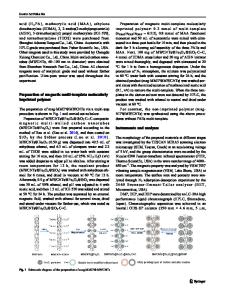Photovoltaic properties of multi walled carbon nanotubes - poly(3-octathiophene) conducting polymer blends structures
- PDF / 268,495 Bytes
- 6 Pages / 432 x 648 pts Page_size
- 53 Downloads / 287 Views
Photovoltaic properties of multi walled carbon nanotubes - poly(3-octathiophene) conducting polymer blends structures Punya A.Basnayaka1,3, Pedro Villalba2, Manoj K. Ram3, 4, Lee Stefanakos3, 5 and Ashok Kumar1, 3
1
Department of Mechanical Engineering, 2Department of Chemical and Biomedical Engineering, Clean Energy Research Center, 4Nanotechnology Research and Education Center, 5Department of Electrical Engineering, University of South Florida, 4202 E Fowler Avenue, ENB 118, Tampa, FL, 33620 3
[email protected], [email protected], [email protected], [email protected], [email protected] Abstract In the present study, we have studied photoelectrochemical properties of poly(3-octathiophene) (P3OT), blending with multi-wall carbon nanotubes (MWCNTs). P3OT blended with MWCNTs was characterized using Scanning Electron Microscope (SEM), Transmission Electron Microscope (TEM), Raman spectroscope, and Cyclic Voltammetry (CV) techniques, respectively. The photoelectrochemical current of the MWCNs-P3OT based cell under illumination was investigated by applying a voltage. The blend consisting of 10% MWCNTs in P3OT gave the promising photocurrent in 0.2 M tetra-butyl-ammonium-tetrafluoroborate (TBATFB), electrolyte. Experimental results indicate that photocurrent obtained from MWCNTP3OT was three times higher than simple P3OT-based conducting polymer. The electrochemical responses of MWCNT-P3OT films in different electrolytes such as 0.2M TBATFB, 0.2 M LiClO4, 1 M H2SO4 and 0.2 M LiBF6 were investigated for comparative photocurrent properties of the photoelectrochemical cell. Keywords: photocurrent, electrolytes, charge carriers, conducting polymers, multi-walled carbon nanotubes 1. Introduction The organic solar cells have been the focus of significant research interest owing to their potential as a low cost path to harvesting energy from sunlight[1]. To date, the most efficient low cost organic solar cells have been built upon the bulk-heterojunction (BHJ) concept, comprising of phase separated blends of solution processed donor and acceptor molecules[2]. The conjugated polymers have been studied for photoelectrochemical cell devices due to their higher electron mobility, low cost and flexibility in the fabrication of the large cells[3]. Besides many other polymers like polyacetylenes (PAs), polyanilines (PANIs) and poly (phenylene-vinylenes) (PPVs), polythiophenes (PThs) were of great interest[1-6]. The promising photo-conversion efficiency in photovoltaic systems in hybrid structures with conjugated polymers in multilayered systems with PbSe, CdS, CdSe, and nanocrystals, have been limited with the use of toxic
139
precursors (i.e,. Cd, Pb etc.). We have studied the photoelectrochemical properties of nanohybrid films fabricated by blending regioregular polyhexylthiophene (RRPHTh) conducting polymer with nanodiamond (ND) nanoparticles, zinc oxide (ZnO), and titanium oxide (TiO2) nanoparticles deposited on indium tin oxide (ITO) coated glass plates, n-type silicon, and gold coated glass substrates[7]. Our previous re
Data Loading...











